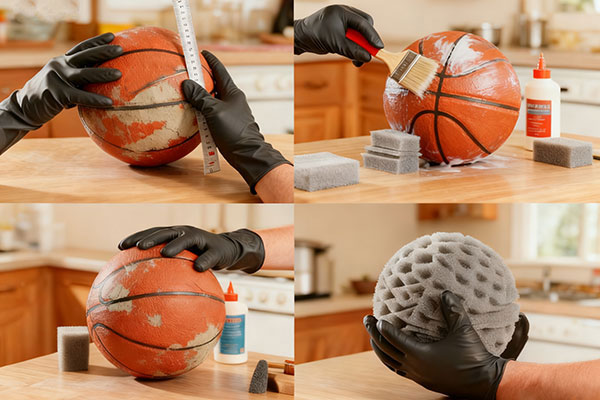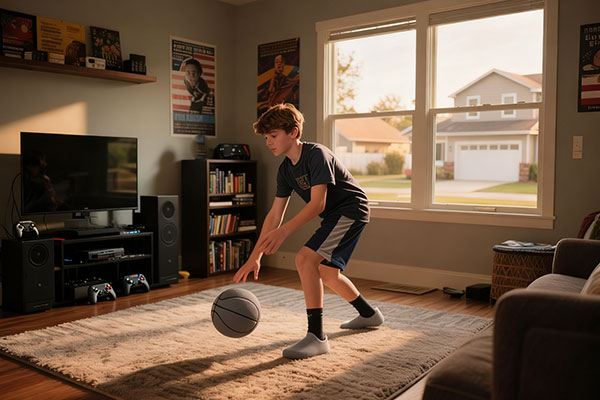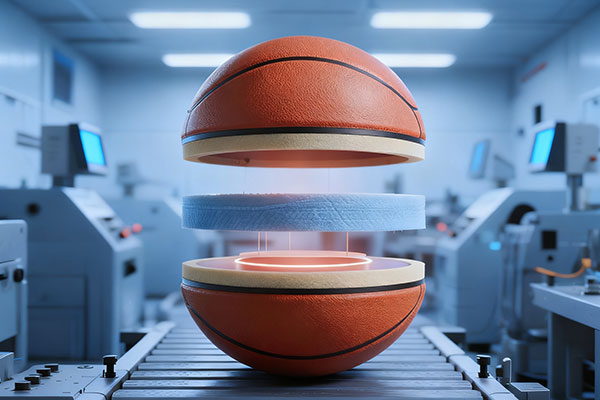Table of Contents

Ever dream of dribbling indoors without the thudding echoes piercing through walls? If you’ve ever disturbed family, neighbors, or roommates while practicing at home, you’re far from alone. That’s why many players are seeking how to make a silent basketball—one that feels authentic yet significantly reduces noise.
In this guide, you’ll learn:
- How does a silent basketball work
- Simple DIY methods you can try at home
- Performance comparisons between DIY and professional models, plus how to choose
- Materials, tools, and safety precautions for DIY projects
Let’s get started.
The Science Behind Noise Reduction in Silent Basketballs
Noise Sources in Regular Basketballs
Basketball noise primarily stems from three factors:
🔊 Hard rubber casing—creates loud thuds upon ground impact
🔊 High internal pressure—enhances bounce but amplifies noise
🔊 Smooth surface—fails to absorb vibration energy
How Does a Silent Basketball Work
🔇 Unlike traditional hard rubber shells, silent basketball use specialized porous foam material to effectively eliminate harsh bounce noises.
🔇 Featuring low-rebound foam layers, they deliver a quiet, cushioned dribbling experience.
🔇 The soft surface material converts impact energy into heat absorption rather than propagating it as sound waves.
They are particularly suitable for:
- Apartment or dorm training
- Late-night basketball training exercises at home
- Indoor basketball practice for children
Essential Materials and Tools for DIY Silent Basketballs

🧰 Basic Materials
- Old or deflated basketball
- Sound-absorbing foam (memory foam or polyurethane foam)
- Epoxy resin adhesive
- Protective topcoat
- Weighting material (e.g., fine sand)
🧰 Tools Required
- Protective gloves and goggles
- Digital scale
- Mixing container
How To Make a Silent Basketball: Three Methods

🏀 Method One: Basic Wrapping Technique (Beginner-Friendly)
First, select a suitable old basketball as the base material and slightly deflate it to soften the ball. Cut the foam material into specific shapes and layer it using eco-friendly adhesive. Ensure thorough adhesion between layers, then seal the surface with a protective coating. This simple method achieves approximately 40% noise reduction.
🏀 Method Two: Internal Filling (Intermediate Difficulty)
This technique requires more skill. Drill a small hole in the basketball, inject a specialized sound-absorbing foam mixture, then precisely seal it. The key is controlling the density and distribution of the filling material to ensure it doesn’t compromise the ball’s balance.
🏀 Method Three: Full Handcrafting (Advanced Solution)
Starting from scratch requires creating a specialized mold. Pour foam materials of varying densities in layers, adding fine sand for weight distribution at the center. Each layer must fully cure and then rest for several hours to dry. This method achieves the best results but demands professional equipment and extensive experience.
Common Challenges and Solutions
The most frequent challenge during production is weight control. Adding sound-absorbing materials increases weight, affecting shooting feel. The solution involves using lighter foam materials and precisely calculating counterweights for balance.
Another challenge is durability, which can be addressed through multi-layer protection and high-quality adhesives.
Performance Testing and Quality Assessment

- Test noise levels on various surfaces
- Verify bounce consistency
- Evaluate surface grip
- Conduct durability tests
✅ Results: Reduced bounce height and significantly lower noise
⚠️ Limitations: Feel differs from authentic basketballs—weight, grip, and texture vary.
⚙️ This DIY version is suitable for experimental use but not professional training.
DIY or Buy?
DIY vs. Commercial Products
| Feature | DIY Silent Basketball | Professional Silent Basketball |
| Cost | Low (DIY) | Moderate |
| Bounce Feel | Unstable | Realistic |
| Durability | Poor (foam peels) | Long-lasting |
| Noise Level | Quiet | Ultra-quiet |
| Grip Feel | Poor | Game-like texture |
Manufacturer's Silent Basketball Production Revealed (Internal Analysis)

Manufacturers employ advanced molding and layering techniques to create durable, realistic silent basketballs. The core process includes:
- Foam Core Molding — Lightweight, high-resilience inner core
- Surface Molding — Anti-slip textured rubber layer
- Sound Absorption Testing — Ensures silent bounce performance
- Wear-resistant coating — prevents moisture-induced tearing
This process makes each ball feel nearly identical to a real basketball while significantly reducing noise levels.
Why Professional Silent Baskets Excel
- Precision-molded foam ensures consistent bounce
- Outer layer delivers authentic feel and texture
- Crack-resistant and peel-proof design
- Weight balance approaches standard ball specifications
These manufacturing techniques align with established principles of sports engineering as documented by leading academic institutions. DIY is fun—but during regular training, you’ll quickly notice the gap between homemade balls and professional silent basketballs.
👉 Conclusion: DIY is great for weekend projects, but professional silent basketballs are essential for formal training.
Safety Precautions
- Always work in well-ventilated areas
- Wear protective gear when using chemical adhesives
- Exercise extreme caution with power tools
- Prepare emergency response plans
Frequently Asked Questions
When should I choose commercial products?
If you need balls for formal training or competition, commercial products are recommended. Professionally manufactured silent basketballs undergo rigorous testing to deliver consistent, reliable performance. Additionally, commercial products offer quality guarantees and after-sales service.
What's the budget for the most economical option?
The basic approach costs approximately $20–50, depending on material choices.
How long does a homemade silent basketball last?
Under normal use, performance can be maintained for 3-6 months.
Which method is best for beginners?
Method One is easiest to master and has the highest success rate.
Conclusion
Exploring how to make a silent basketball deepens your understanding of noise reduction principles. However, for indoor skill development, professionally designed silent basketballs offer the perfect balance of authentic feel, quiet performance, and durability.
If you develop a deep interest in this field, consider:
- Expanding your knowledge of materials science
- Attending relevant workshops
- Connecting with manufacturers
Transform your hobby into a profession. If you find the process cumbersome or desire a professional experience, simply purchase a professional [Airless Basketball] for immediate use.
Whether buying or building your own, the goal remains the same—train consistently, stay focused, and enjoy the game without disturbing others.
Safety Note: All DIY projects carry inherent risks. Always perform under adult supervision and strictly adhere to safety protocols. If you have any concerns about the manufacturing process, we recommend purchasing professional products directly.
